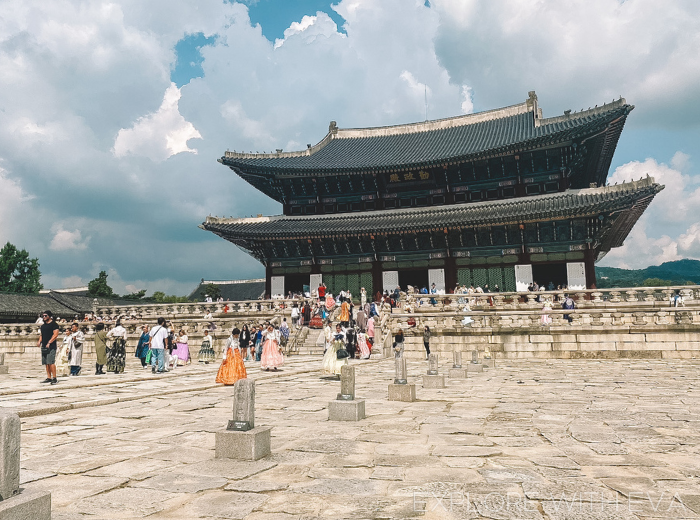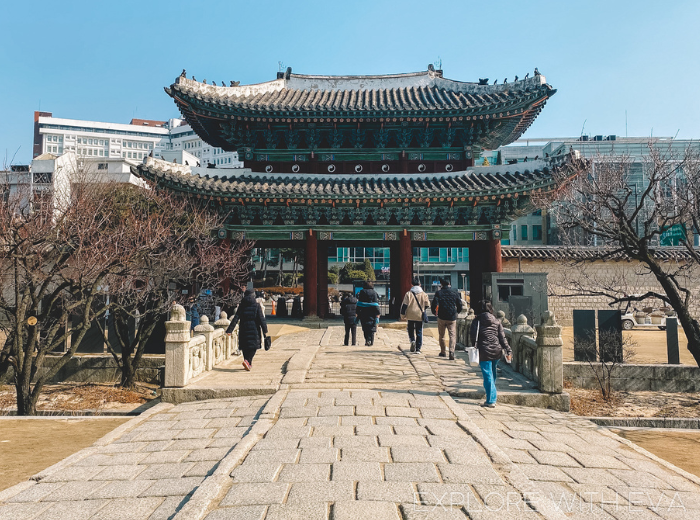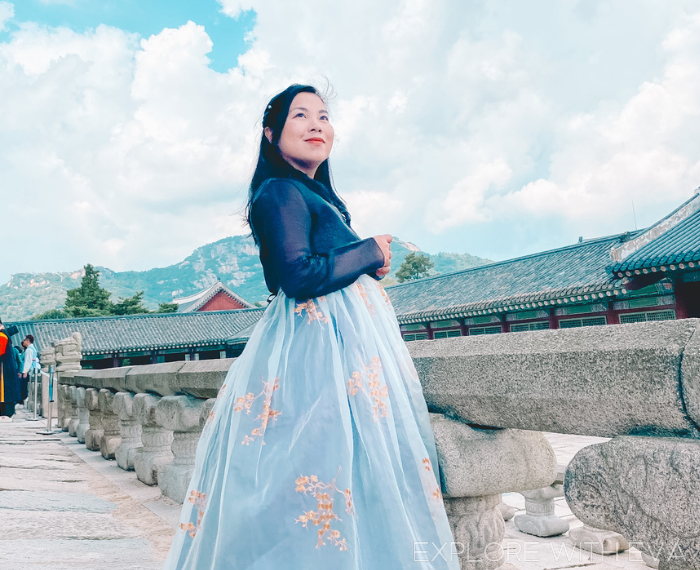Seoul, the capital of South Korea, is home to four stunning palaces that reflect the country's rich history. These palaces are Gyeongbokgung, Changdeokgung, Changgyeonggung, and Deoksugung, and they are places to add to your Seoul itinerary if they aren't there yet.
Let's take a closer look at each of them.
- Gyeongbokgung Palace
- Changdeokgung Palace
- Changgyeonggung Palace
- Deoksugung Palace
- Getting Free Access to the Palaces
Gyeongbokgung Palace
Gyeongbokgung Palace is the largest and most famous of Seoul's palaces. It was built in 1395 during the Joseon Dynasty and served as the main royal residence. Its name means “Palace Greatly Blessed by Heaven” and it's because of its placement between mountains Bugaksan and Namsan.
Here you can see impressive buildings like Geunjeongjeon Hall and Gyeonghoeru Pavilion. You can also witness the Changing of the Guard ceremony, which takes place against the backdrop of Gwanghwamun Gate, the imposing entrance to the palace. Additionally, you can stroll through the meticulously landscaped gardens and admire the intricate designs of the palace structures that offer a glimpse into Korea's past.
 |
| Gyeongbokgung Palace |
Entrance Fee: KRW3,000 for adults | KRW1,500 for under 18 | FREE for seniors and under 6
How to Get to Gyeongbokgung Palace
You really can’t miss it once you’re in the area. Take Seoul Subway Line 3 (Orange Line) and get off at Gyeongbokgung Station Exit 5. Walk straight for about 5 minutes, and you'll see the entrance to the palace on your left.
Alternatively, you can take the Seoul Subway Line 5 (Purple Line) and get off at Gwanghwamun Station Exit 2. Once you exit the station, walk straight and you’ll see the main entrance gate right away.
Changdeokgung Palace
Built in 1405, Changdeokgung Palace is known for its beautiful integration with nature. It was destroyed during the Japanese occupation but was eventually rebuilt, and it served as the royal residence during the 1600s to1800s.
One of the highlights of this palace complex is the Secret Garden called "Huwon", offering peaceful walks among ponds and pavilions. This palace is a UNESCO World Heritage Site since 1997 and a must-visit for its serene atmosphere.
 |
| Changdeokgung Palace |
How to Get to Changdeokgung Palace
Take the Seoul Subway Line 3 (Orange Line) and get off at Anguk Station Exit 3. Walk straight for about 5 minutes, and you'll reach the entrance to Changdeokgung Palace on your right.
Changgyeonggung Palace
Originally constructed as a residence for queens and concubines, Changgyeonggung Palace has gone through several transformations throughout its history. Even though it faced periods of neglect and destruction, the palace has been restored to its former glory, offering visitors a glimpse into its storied past.
Changgyeonggung's charm lies in its understated elegance and tranquil ambiance. Its architecture and lush gardens provide a nice escape from the bustling city streets of Seoul while giving a deeper insight into Korea's heritage.
 |
| Changgyeongung Palace |
How to Get to Changgyeonggung Palace
The easiest way to get to Changgyeonggung Palace is by taking the Seoul Subway Line 4 (Light Blue Line) and getting off at Hyehwa Station Exit 4. Then walk straight for about 10 minutes, and you'll find the entrance to the palace.
You can also take the Subway Line 3 (Orange Line) to Anguk Station and use Exit 3. From there walk for 10 minutes along Yulgok-ro and then turn left onto Changgyeonggung-ro, then walk for about 5 more minutes until you reach the entrance.
If you're coming from Changdeokgung Palace, then you can easily access Changgyeonggung Palace as these palaces are connected.
Deoksugung Palace
Deoksugung Palace features a unique blend of traditional Korean architecture and Western influences, making it different from the other palaces. Built during the Joseon Dynasty and expanded upon during the late 19th and early 20th centuries, this palace served as a temporary residence for royalty.
Merging Korean-style buildings and Western structures in one place, the Seokjojeon Hall and Jeonggwanheon Pavilion are a reflection of Korea's evolving cultural landscape. You can stroll through the palace grounds to get a glimpse into the intersection of tradition and modernity in Korean history.
 |
| Deoksugung Palace |
How to Get to Deoksugung Palace
Take Seoul Subway Line 1 (Dark Blue Line) and get off at City Hall Station Exit 2. Walk straight for about 5 minutes, and you'll reach the entrance to Deoksugung Palace.
Getting Free Access to the Palaces
There are a few ways how to enter these palaces for free.
If you're wearing a hanbok, the traditional Korean attire, you may be eligible for free entry to some of Seoul's majestic palaces. This is a nod to Korea's rich cultural heritage and encourages visitors to immerse themselves fully in the traditional experience. Many of Seoul's palaces, such as Gyeongbokgung and Changdeokgung, offer complimentary admission to those dressed in hanbok, adding an extra layer of authenticity to your visit.
 |
| enter some palaces for free when you wear a hanbok |
Another is by keeping a lookout on special admission days during your trip. For example, Gyeongbokgung Palace, the largest and most famous palace in Seoul, offers free admission on certain days such as the last Wednesday of each month. You also get to enter these palaces during big holidays like Chuseok, which is their version of Thanksgiving, and Seollal or Lunar New Year.
Lastly, if you get the Discover Seoul Pass, then you get free entry to these four palaces and over 80 attractions and activities in Seoul. It's a cost-effective way to visit the popular tourist places in the city. It also works as a transportation card. You just have to reload it at convenience stores or at train stations and you can use it to pay for your bus and subway rides in South Korea.
I'd highly recommend visiting these palaces if you're traveling to Seoul. These places are more than just historic sites as they're living reminders of Korea's vibrant history. If you have any questions, drop a comment below.




0 Comments